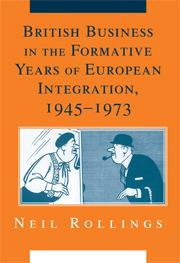Book contents
- Frontmatter
- Contents
- List of Tables and Figure
- Series Editors' Preface
- Acknowledgements
- Abbreviations
- 1 Introduction
- PART I ECONOMIC REALITIES
- PART II THE DEVELOPMENT OF PERCEPTIONS OF EUROPEAN INTEGRATION
- 4 From 1945 to June 1955: The Marshall Plan and the European Coal and Steel Community
- 5 The Establishment of the Common Market and the Free Trade Area Proposals, 1955–1958
- 6 Creating EFTA, Applying to the EC, and de Gaulle's Veto, 1958–1963
- 7 After de Gaulle's First Veto, the Second Application, and the Second Veto, 1963–1968
- 8 The End Game: From the Hague Summit to British Accession, 1969–1973
- PART III EUROPEAN INTEGRATION AS MORE THAN TARIFFS
- Conclusion
- Index
7 - After de Gaulle's First Veto, the Second Application, and the Second Veto, 1963–1968
from PART II - THE DEVELOPMENT OF PERCEPTIONS OF EUROPEAN INTEGRATION
Published online by Cambridge University Press: 02 December 2009
- Frontmatter
- Contents
- List of Tables and Figure
- Series Editors' Preface
- Acknowledgements
- Abbreviations
- 1 Introduction
- PART I ECONOMIC REALITIES
- PART II THE DEVELOPMENT OF PERCEPTIONS OF EUROPEAN INTEGRATION
- 4 From 1945 to June 1955: The Marshall Plan and the European Coal and Steel Community
- 5 The Establishment of the Common Market and the Free Trade Area Proposals, 1955–1958
- 6 Creating EFTA, Applying to the EC, and de Gaulle's Veto, 1958–1963
- 7 After de Gaulle's First Veto, the Second Application, and the Second Veto, 1963–1968
- 8 The End Game: From the Hague Summit to British Accession, 1969–1973
- PART III EUROPEAN INTEGRATION AS MORE THAN TARIFFS
- Conclusion
- Index
Summary
De Gaulle's veto in January 1963 marked the end of negotiations over British entry at that time. It was a further ten years before the UK finally joined the European Community. A Labour government was elected in 1964 with little overt interest in European integration. However, led by Harold Wilson, the government shifted its position, launching a second bid for entry in 1967, but again de Gaulle vetoed the application. This left little prospect of EC enlargement in the foreseeable future but also created a crisis in the EC. The attitude of British business to European integration also developed considerably after the first veto. The first reaction to the 1963 veto was a mixture of relief that at least business knew where it stood and an ensuing sense of reflection and reassessment, which, in turn, led to a diverse range of responses. Slowly this was replaced by renewed enthusiasm for entry, stimulated by the creation in 1965 of the Confederation of British Industry (CBI) out of the merger of the Federation of British Industries (FBI), the British Employers' Confederation (BEC) and the National Association of British Manufacturers (NABM) (until 1963 the National Union of Manufacturers). This created a single voice for British industry, with the Association of British Chambers of Commerce (ABCC) taking much more of a backseat role.
- Type
- Chapter
- Information
- Publisher: Cambridge University PressPrint publication year: 2007



